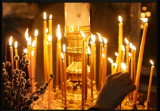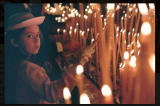Why Do We Light Candles? (http://stgeorgepa.net/about/what-is-the-orthodox-faith/faqs/why-do-we-light-candles/)
The first thing anyone notices upon entering any Orthodox Church is the sandbox full of lit candles. We see people making an offering, taking the candle, lighting it, saying a prayer and placing the candle in the sand. So what is this all about?
Christ said, “I am the light of the world; he who follows me will not walk in darkness, but will have the light of life.” (John 8:12) Jesus Christ IS that light. He is the light that shines for us in the midst this world of darkness. And anyone who follows Him needs not fear that darkness because we know that Christ will always shine for us, leading us in the Way to the Father. Each time we light a candle, we are called to remember that it is our Lord and Savior Jesus Christ who is the True Light and that He and only He will grant us True Life.
Every candle that we light should be a time of prayer in which we reflect upon the salvation that the Lord has worked for us and also a time of recommitment, where we renew our Baptismal vow that we, as children of God, are called to “Let our light so shine before men, that they may see [our] good works and give glory to [our] Father who is in Heaven.” (Matt. 5:16)
In lighting our candles, the first thing we should do is make an offering for this candle. Everything that we have is from God and the first step is to give back to Him for all of His many blessings. The next step is to venerate the icons that guard the sandbox and lift our prayers to God on high. Next, we light the candle, remembering all of our loved ones who are sick or who have passed into the next life, or who we just want to pray for, and beseech God to have mercy on their souls.
Lastly, as we place the candle in the sand, we quietly say “Lord have mercy,” repenting for our own sinfulness while at the same time “re-igniting” our own flame and recommitting our whole life to God. Thus we begin again to live as light, helping others see the Way in a world of darkness.
Candles in Orthodox Worship (http://www.stjohnaz.org/index.cfm/resources/attending-divine-services/the-candle/)
Candles appeared in all Orthodox churches in the first centuries of our era. Eusebius of Caesaria records that during the paschal vigil such a quantity of candles were lit by the faithful that the night itself became as day. There were wax candles the sizes of which made them look like actual pillars. In answer to the accusations of the schismatic Vigilantius, who berated the Orthodox for lighting candles in their churches during daylight also, St. Jerome (342-420) says "in all Eastern churches candles are lit during the reading of the Gospel not only so as to shed light and dispel the gloom but also to proclaim one's joy."
Over the centuries, the Orthodox candle has burnt gently and humbly and is now, as it was then, imbued with profound meaning, inalienable from our Orthodox divine services and Orthodox piety. Apart from the fact that the small sacrifice, the mite given by each Christian for the candle he lights, benefits the Church in real terms, by lighting a candle, each Christian enters into closer contact with the church and the service, participating in it more actively and invisibly warming his soul by the visible light of the candle. We must understand that man's immortal soul dwells in man's mortal body.
The immortal soul cannot be indifferent to pious deeds committed by the body which is its home. As the body bows, so does the soul bow with it and grows obedient. We are human; we need to see, to feel, to smell and to hear. And in the church, candles burn with the divine light; the ringing of bells sanctifies the air; incense reminds us of the fragrance of prayers; and from each icon the Saviour Himself, the Mother of God and all the saints mysteriously look at us and we look at Their holy images as two worlds come face to face: the dwellers of the Kingdom of God and we, the sinners.
Pious Orthodox people will preserve throughout the year the candles they light during the readings of the Passion Gospels on Holy Thursday. They make a sign of the cross with these candles over the doors to their homes. They light them during difficult moments of their lives. On Pasch night, the candles born by the faithful transform their faces into living icons on which plays the light of God's grace .
But the candle has yet another profound meaning. The burning candle represents the entire life of the faithful, from birth to death. It stands for the inner flame of love for and devotion to God. A Christian should burn like a candle before God, and his whole being should gradually be consumed by this divine flame thus marking the end of his earthly life.
Blessed Simeon of Thessalonica (15th century), commentator on the Liturgy, states that pure wax symbolizes the purity and chastity of those who offer it. It is offered as a sign of our having repented of stubbornness and self-will. The softness and pliability of wax speaks of our readiness to obey God. The burning of the candle represents man's deification, his becoming a new creature through the fire of God's love.
Moreover, the candle is a witness to faith, of man's belonging to the Divine light. It expresses the flame of our love for the Lord, for the Mother of God, for the angels, or for the saints. One must not light a candle with a cold heart, merely as a formality. The external action must be supplemented by prayer, if only the simplest one, using one's own words.
A lighted candle is present at many church services. It is held by the newly baptized and by those being joined together in the Mystery of Matrimony. The funeral rite is performed amidst a multitude of burning candles. Protecting their burning candles from the wind, the faithful walk in Processions of the Cross.
There are no absolute rules as to where or how many lighted candles must be offered. Their purchase is a little sacrifice to God, voluntary and not burdensome. A large and expensive candle is no more grace-giving than is a small one.
Those who are meticulous about attending church try to light several candles during each visit: before the festal icon at the center of the church, at the icon of the Savior or of the Mother of God; for the health of their loved ones, and on the rectangular candlestand (kanun) before the Cross; for the repose of the souls of the deceased. If the heart so wishes, one may light candles to any saint or saints.
Sometimes it so happens that all of the spaces on the candlestand are filled, leaving no place to set a lighted candle. One should not extinguish an already-burning candle and replace it with one's own. It is better to ask one of the attendants to light it for you at an appropriate moment. One should not be upset if, at the end of the Service, your candle is extinguished; the sacrifice has already been accepted by God.
There is no reason to believe talk that one should set a candle only with the right hand, that if it should go out, it is a sign misfortune will follow, that to singe the base of the candle to make it fit more firmly into the receptacle is a deadly sin, etc. There are many such superstitions, and they are all meaningless.
The burning wax candle is pleasing to God, but He prizes the burning of the heart even more. Our spiritual life, our participation in church services, is not limited to the candle. The candle will not free us from sin, will not unite us with God, and will not give us the power to wage the unseen warfare. The candle is filled with symbolic meaning, but we are saved not by symbols, but by the full reality, Divine grace.
Also, see http://www.johnsanidopoulos.com/2010/02/use-of-candles-in-orthodox-church.html



 Orthodoxy in America
Orthodoxy in America

